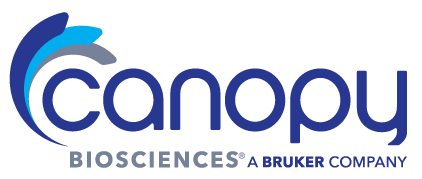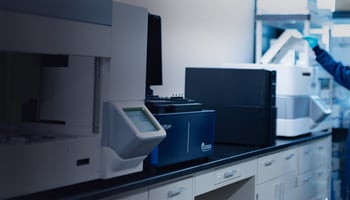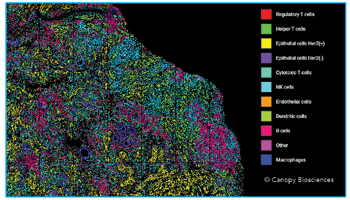What is Digital Spatial Profiling?
Spatial Biology Q&A: Developing new protocols to expand the utility of ChipCytometry™

Researcher Spotlight
Developing new protocols to expand the utility of ChipCytometry™
Featuring Sebastian Jarosch, MSc
Institute for Medical Microbiology, Immunology, and Hygiene, Technical University of Munich
"We have developed a series of protocols to expand the utility of ChipCytometry into new applications. Applying these protocols, we characterize clinical samples from patients with graft-versus-host disease to develop novel therapeutic strategies.” – Sebastian Jarosch, MSc
Tell us a little about yourself.
I performed my PhD work at the Institute for Medical Microbiology, Immunology, and Hygiene at Technical University of Munich, supervised by Professor Dirk Busch. Here, the lab’s goal is to identify therapeutically relevant, T cell-mediated defense mechanisms that can be targeted to treat patients in the area of infectious diseases. After graduation, I will start a new position as Research Scientist at Boehringer Ingelheim.
What is your specific area of research interest or projects?
I completed my doctoral research on characterizing the immune cell landscape in patients with acute graft-versus-host disease to unravel the connection between microbiome, immune cells, and disease outcome. To do this, we use a multi-omics approach, correlating microbiome data with data from multiplexed imaging and single-cell RNA sequencing methods. In addition to this main project, we have developed several protocols to expand the utility of ChipCytometry for new applications, specifically in the areas of RNA detection, data analysis, and FFPE tissues.
How have Canopy's products or services fit into your overall research goals?
We use ChipCytometry to characterize the immune microenvironment in tissues from patients with graft-versus-host disease. ChipCytometry has helped us to decipher the enormous complexity of tissue biology by profiling the spatial relationship between cells with different phenotypes. To more deeply characterize these unique patient tissues, we developed a protocol that combines ChipCytometry antibody staining and RNA in situ hybridization on a single sample. The protocol, published in STAR Protocols, has allowed us to add an additional layer of information to our ChipCytometry experiments. After my departure, two new graduate students will take over ChipCytometry data generation and analysis for their own research projects.
How is ChipCytometry data analyzed?
The high staining quality and single-cell resolution of our ChipCytometry data allowed us to develop an open-source pipeline for analysis. With our code, the user can automatically quantify signal intensities from exported images. In our recent publication, we resolved 90% of all nucleated cells, demonstrating the importance of both high-quality data and cell-type-specific segmentation. The lab is currently maintaining the pipeline with the latest versions of algorithms for cell segmentation and signal quantification to support a number of additional ChipCytometry projects. We encourage new users to test the pipeline on their own datasets and provide feedback using GitHub’s collaborative coding features.
What aspects of this technology ultimately led you to choose ChipCytometry?
Precision imaging and platform flexibility were the two most important features for us. We liked that ChipCytometry achieves true single-cell resolution with high-quality optical components and the unique high-dynamic range (HDR) image acquisition. Specifically, HDR imaging is a key feature that has facilitated precise quantification of cell populations in a variety of tissue samples. In terms of flexibility, we liked that the ChipCytometry platform allows us to use fluorescent antibodies from any vendor and preserves the tissue after image acquisition to enable reinterrogation.
How have open-source reagents benefited your research?
ChipCytometry allows us to tap into the vast source of commercially available fluorescent antibodies. This has allowed us a tremendous amount of flexibility to test a variety of antibodies from multiple vendors, selecting only those in which we have the highest degree of confidence. This is an important feature given the significance of validating antibodies to produce the highest quality datasets.
How does ChipCytometry work with archival FFPE tissues?
ChipCytometry was originally developed for cell suspensions and FF tissues. We developed a protocol published in Cell Reports Methods, that expands the utility of ChipCytometry into FFPE tissues. The protocol involves sample preparation and a staining procedure and includes critical steps for deparaffinization and antigen retrieval. With this protocol, we demonstrated high-quality staining in a variety of archival FFPE tissues including colon, breast, and pancreas. This is an important advance for medical research considering the large quantities of archival FFPE tissue available for research in biorepositories.
Why is precision imaging important for your studies?
Quantification depends heavily on imaging quality. We can extract highly quantitative information from our datasets because of the high-quality imaging. ChipCytometry image quality comes down to two things: optical components and high-dynamic range (HDR) imaging. HDR imaging allows better resolution between low and high signal intensities, while high-quality optical components enable true single-cell resolution. Together, these elements set ChipCytometry apart from other multiplexed imaging methods.
How does ChipCytometry compare to other spatial platforms?
In addition to ChipCytometry, we also have experience with RNA in situ hybridization and single-cell RNA sequencing. We have found that each platform offers a unique dataset for complementary analyses. Our multi-omics approach has facilitated our understanding of tissue biology and has helped paint a clearer picture of molecular mechanisms underlying disease pathology, in a way that is not possible with a single technique or approach.
How does a multi-omics approach add value to your research
A multi-omics approach enables a more comprehensive understanding of molecular mechanisms at play in graft-versus host disease. In our work specifically, we are interested in the similarities and differences in expression profiles across transcriptomic and proteomic datasets. Taking a multi-omics approach has facilitated these complex analyses for a deeper understanding of the tissue biology. Our ChipCytometry datasets have been an important component of this research, allowing us to investigate the spatial component as an additional parameter important for biological processes.
What applications is ChipCytometry suitable for?
Highly multiplexed tissue imaging is extremely relevant right now and is really making waves in biomedical discovery. ChipCytometry is a demonstrated technology useful for basic research as well as broad applications in clinical histopathology. Advances in microscope sensitivity and integration with multi-omics techniques will be important to move highly multiplexed tissue imaging forward in important ways. Spatial biology platforms with enhanced detection sensitivity and integrative capabilities will be better positioned to lead the advance.
For Research Use Only. Not for use in diagnostic procedures.
Related Publications
Jarosch, S., Köhlen, J., Sarker, R. S. J., Steiger, K., Janssen, K.-P., Christians, A., Hennig, C., Holler, E., D’Ippolito, E., & Busch, D. H. (2021). Multiplexed imaging and automated signal quantification in formalin-fixed paraffin-embedded tissues by ChipCytometry. Cell Reports Methods, 1(7), 100104. https://doi.org/10.1016/j.crmeth.2021.100104
Jarosch, S., Köhlen, J., Wagner, S., D’Ippolito, E., & Busch, D. H. (2022). ChipCytometry for multiplexed detection of protein and mRNA markers on human FFPE tissue samples. STAR Protocols, 3(2), 101374. https://doi.org/10.1016/j.xpro.2022.101374
Koch, M. R., Gong, R., Friedrich, V., Engelsberger, V., Kretschmer, L., Wanisch, A., Jarosch, S., Ralser, A., Lugen, B., Quante, M., Vieth, M., Vasapolli, R., Schulz, C., Buchholz, V. R., Busch, D. H., Mejías-Luque, R., & Gerhard, M. (2022). CagA-specific gastric CD8+ tissue-resident T cells control Helicobacter pylori during the early infection phase. Gastroenterology, S0016508522014433. https://doi.org/10.1053/j.gastro.2022.12.016
Orberg, E. T., Meedt, E., Hiergeist, A., Xue, J., Ghimire, S., Tiefgraber, M., Göldel, S., Eismann, T., Schwarz, A., Jarosch, S., Steiger, K., Gigl, M., Kleigrewe, K., Fischer, J., Janssen, K.-P., Quante, M., Heidegger, S., Herhaus, P., Verbeek, M., … Poeck, H. (2022). Identification of Protective, Metabolite-producing Bacterial and Viral Consortia in Allogeneic Stem Cell Transplantation Patients [Preprint]. https://doi.org/10.21203/rs.3.rs-1504704/v1
Ralser, A., Dietl, A., Jarosch, S., Engelsberger, V., Wanisch, A., Janssen, K. P., Vieth, M., Quante, M., Haller, D., Busch, D. H., Deng, L., Mejías-Luque, R., & Gerhard, M. (2022). Helicobacter pylori promotes colorectal carcinogenesis by deregulating intestinal immunity and inducing a mucus-degrading microbiota signature [Preprint]. https://doi.org/10.1101/2022.06.16.22276474



